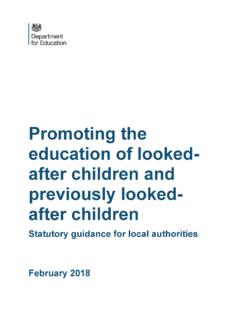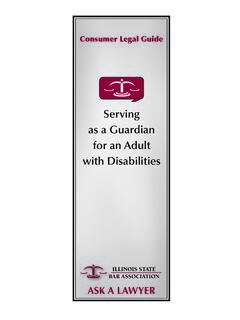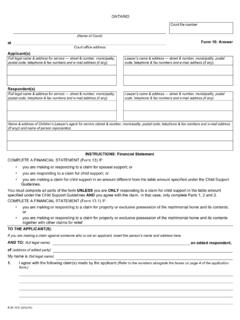Transcription of HINDU MARRIAGE ACT, 1955
1 [Act No. 25 of Year 1955, dated 18th. May, 1955] HINDU MARRIAGE ACT, 1955 CHAPTER I: PRELIMINARY1. Short title and extent2. Application of Act3. Definitions4. Overriding effect of ActCHAPTER II: HINDU MARRIAGES5. Conditions for a HINDU marriage6. guardianship in marriage7. Ceremonies for a HINDU marriage8. Registration of HINDU marriagesCHAPTER III: RESTITUTION OF CONJUGAL RIGHTS AND JUDICIAL SEPARATION9. Restitution of conjugal rights10. Judicial separationCHAPTER IV: NULLITY OF MARRIAGE AND DIVORCE11. Void marriages12. Voidable marriages13. Divorce7[13A. Alternate relief in divorce proceedings13B. Divorce by mutual consent14. No petition for divorce to be presented within one year of marriage15. Divorced persons when may marry again17[16. Legitimacy of children of void and voidable marriages1 of Punishment of bigamy18.]]
2 Punishment for contravention of certain other conditions for a HINDU marriageCHAPTER V: JURISDICTION AND PROCEDURE1[19. Court to which petition shall be presented20. Contents and verification of petitions21. Application of Act 5 of 190821[21A. Power to transfer petitions in certain cases21B. Special provision relating to trial and disposal of petitions under the Act21C. Documentary evidence1[22. Proceedings to be in camera and may not be printed or published23. Decree in proceedings7[23A. Relief for respondent in divorce and other proceedings24. Maintenance pendente lite and expenses of proceedings25. Permanent alimony and maintenance26. custody of children27. Disposal of property1[28. Appeals from decrees and orders28A. Enforcement of decrees and ordersCHAPTER VI: SAVING AND REPEAL29.]]]]]
3 Saving30. RepealFoot Notes An Act to amend and codify the law relating to MARRIAGE among Hindus 2 of it enacted by Parliament in the Sixth Year of the Republic of India as follows: - CHAPTER I: PRELIMINARY 1. Short title and extent (1) This Act may be called the HINDU MARRIAGE Act, 1955. (2) It extends to the whole of India except the State of Jammu and Kashmir, and applies also to Hindus domiciled in the territories to which this Act extends who are outside the said territories. 2. Application of Act (1) This Act applies (a) to any person who is a HINDU by religion in any of its forms or developments, including a Virashaiva, a Lingayat or a follower of the Brahmo, Prarthana or Arya Samaj, (b) to any person who is a Buddhist, Jaina or Sikh by religion, and (c) to any other person domiciled in the territories to which this Act extends who is not a Muslim, Christian, Parsi or Jew by religion, unless it is proved that any such person would not have been governed by the HINDU law or by any custom or usage as part of that law in respect of any of the matters dealt with herein if this Act had not been passed.
4 Explanation : The following persons are Hindus, Buddhists, Jainas or Sikhs by religion, as the case may be:- (a) any child, legitimate or illegitimate, both of whose parents are Hindus, Buddhists, Jainas or Sikhs by religion; (b) any child, legitimate or illegitimate, one of whose parents is a HINDU , Buddhist, Jaina or Sikh by religion and who is brought up as a member of the tribe, community, group or family to which such parent belongs; and (c) any person who is a convert or re-convert to the HINDU , Buddhist, Jaina or Sikh religion. (2) Notwithstanding anything contained in sub-section (1), nothing contained in this Act shall apply to the members of any Scheduled Tribe within the meaning of clause (25) of article 366 of the Constitution unless the Central Government, by notification in the Official Gazette, otherwise directs.
5 (3) The expression " HINDU " in any portion of this Act shall be construed as if it included a person who, though not a HINDU by religion, is, nevertheless, a person to whom this Act applies by virtue of the provisions contained in this section. 3 of Definitions In this Act, unless the context otherwise requires, (a) the expressions "custom" and "usage" signify any rule which, having been continuously and uniformly observed for a long time, has obtained the force of law among Hindus in any local area, tribe, community, group or family: PROVIDED that the rule is certain and not unreasonable or opposed to public policy: PROVIDED FURTHER that in the case of a rule applicable only to a family it has not been discontinued by the family; (b) "district court" means, in any area for which there is a city civil court, that court, and in any other area the principal civil court of original jurisdiction, and includes any other civil court which may be specified by the State Government, by notification in the Official Gazette, as having jurisdiction in respect of the matters dealt with in this Act; (c) "full blood" and "half blood" -two persons are said to be related to each other by full blood when they were descended from a common ancestor by the same wife and by half blood when they are descended from a common ancestor but by different wives.
6 (d) "uterine blood"- two persons are said to be related to each other by uterine blood when they are descended from a common ancestress but by different husbands; Explanation: In clauses (c) and (d), "ancestor" includes the father and "ancestress" the mother; (e) "prescribed" means prescribed by rules made under this Act; (f) (i) "sapinda relationship" with reference to any person extends as far as the third generation (inclusive) in the line of ascent through the mother, and the fifth (inclusive) in the line of ascent through the father, the line being traced upwards in each case from the person concerned, who is to be counted as the first generation; (ii) two persons are said to be "sapindas" of each other if one is a lineal ascendant of the other within the limits of sapinda relationship, or if they have a common lineal ascendant who is within the limits of sapinda relationship with reference to each of them; (g) "degrees of prohibited relationship" -two persons are said to be within the "degrees of prohibited relationship"- (i) if one is a lineal ascendant of the other; or (ii) if one was the wife or husband of a lineal ascendant or descendant of the other; or (iii) if one was the wife of the brother or of the father s or mother s brother or of the grandfather s or grandmother s brother of the other.
7 Or 4 of (iv) if the two are brother and sister, uncle and niece, aunt and nephew or children of brother and sister or of two brothers or of two sisters; Explanation: For the purposes of clauses (f) and (g), relationship includes- (i) relationship by half or uterine blood as well as by full blood; (ii) illegitimate blood relationship as well as legitimate; (iii) relationship by adoption as well as by blood; and all terms of relationship in those clauses shall be construed accordingly. 4. Overriding effect of Act Save as otherwise expressly provided in this Act- (a) any text, rule or interpretation of HINDU law or any custom or usage as part of that law in force immediately before the commencement of this Act shall cease to have effect with respect to any matter for which provision is made in this Act; (b) any other law in force immediately before the commencement of this Act shall cease to have effect insofar as it is inconsistent with any of the provisions contained in this Act.
8 CHAPTER II: HINDU MARRIAGES 5. Conditions for a HINDU MARRIAGE A MARRIAGE may be solemnised between any two Hindus, if the following conditions are fulfilled, namely,- (i) neither party has a spouse living at the time of the MARRIAGE ; 1[(ii) at the time of the MARRIAGE , neither party- (a) is incapable of giving a valid consent to it in consequence of unsoundness of mind; or (b) though capable of giving a valid consent, has been suffering from mental disorder of such a kind or to such an extent as to be unfit for MARRIAGE and the procreation of children ; or (c) has been subject to recurrent attacks of insanity 2[**] (iii) the bridegroom has completed the age of 3[twenty-one years] and the bride, the age of 4[eighteen years] at the time of the MARRIAGE ; 5 of (iv) the parties are not within the degrees of prohibited relationship, unless the custom or usage governing each of them permits of a MARRIAGE between the two; (v) the parties are not sapindas of each other, unless the custom or usage governing each of them permits of a MARRIAGE between the two; 5[* * *] 6.]
9 guardianship in MARRIAGE [Repealed by the Child MARRIAGE Restraint (Amendment) Act, 1978, 1-10-1978.] 7. Ceremonies for a HINDU MARRIAGE (1) A HINDU MARRIAGE may be solemnised in accordance with the customary rites and ceremonies of either party thereto. (2) Where such rites and ceremonies include the saptapadi (that is, the taking of seven steps by the bridegroom and the bride jointly before the sacred fire), the MARRIAGE becomes complete and binding when the seventh step is taken. 8. Registration of HINDU marriages (1) For the purpose of facilitating the proof of HINDU marriages, the State Government may make rules providing that the parties to any such MARRIAGE may have the particulars relating to their MARRIAGE entered in such manner and subject to such conditions as may be prescribed in a HINDU MARRIAGE Register kept for the purpose.
10 (2) Notwithstanding anything contained in sub-section (1), the State Government may, if it is of opinion that it is necessary or expedient so to do, provide that the entering of the particulars referred to in sub-section (1) shall be compulsory in the State or in any part thereof, whether in all cases or in such cases as may be specified, and where any such direction has been issued, any person contravening any rule made in this behalf shall be punishable with fine which may extend to twenty-five rupees. (3) All rules made under this section shall be laid before the State Legislature, as soon as may be, after they are made. (4) The HINDU MARRIAGE Register shall at all reasonable times be open for inspection, and shall be admissible as evidence of the statements therein contained and certified extracts therefrom shall, on application, be given by the Registrar on payment to him of the prescribed fee.






